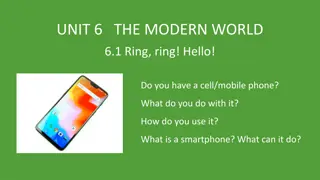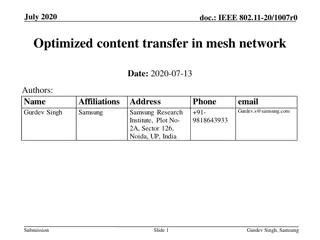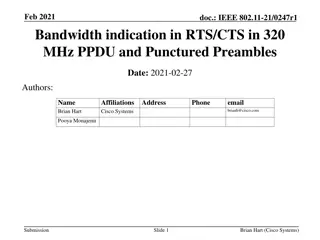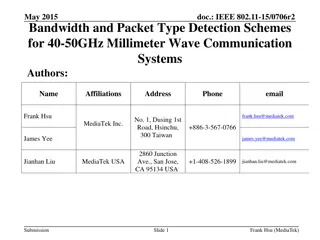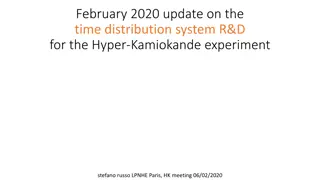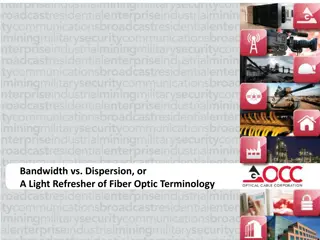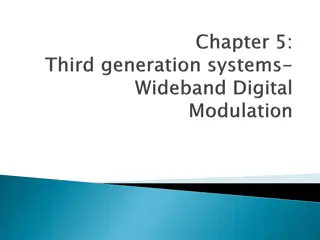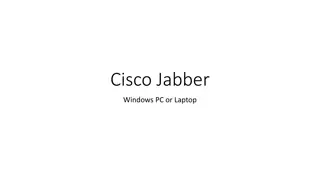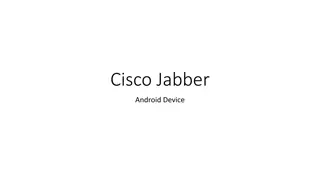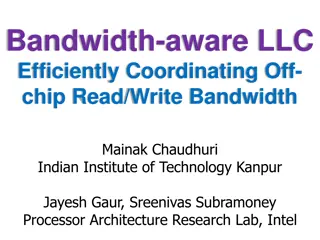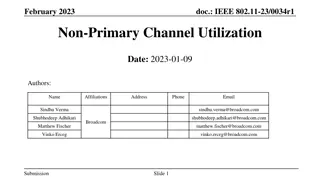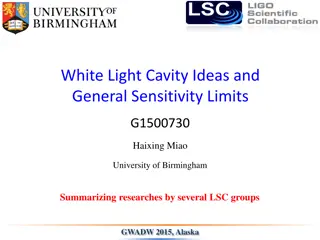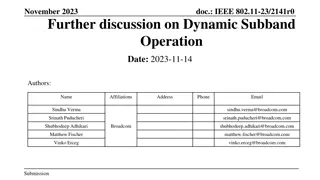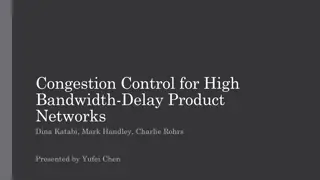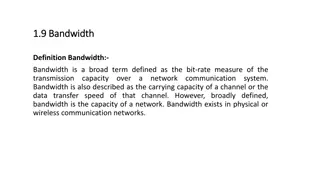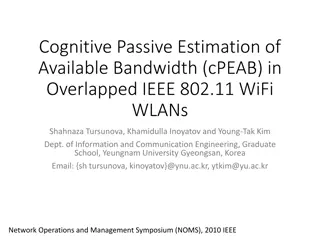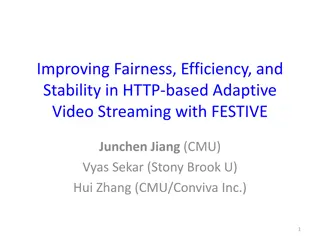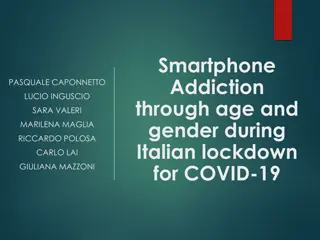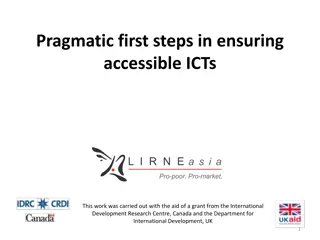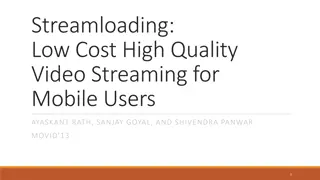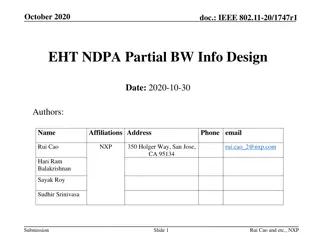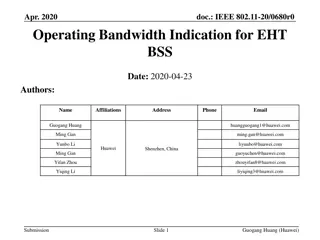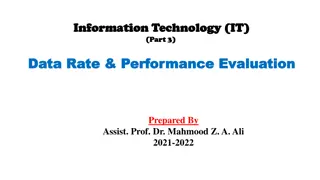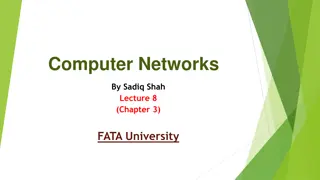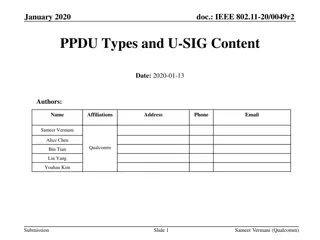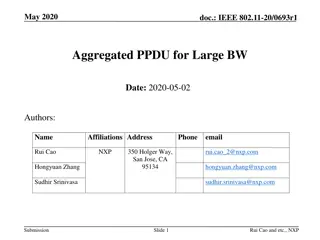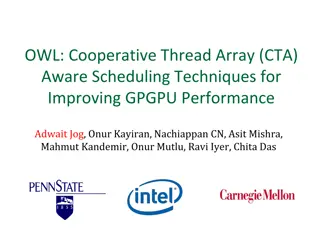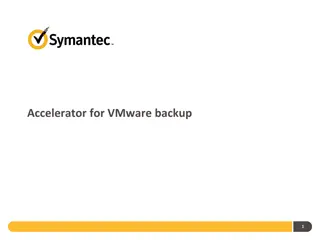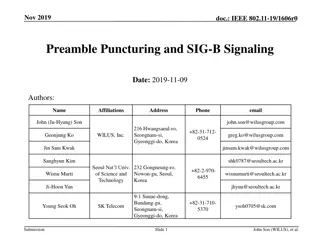Towards Low-Bandwidth Video Chats on Smartphones
This study by Xin Qi, Qing Yang, David T. Nguyen, Gang Zhou, and Ge Peng from the College of William and Mary focuses on reducing data usage in video chats on smartphones. The research explores methods such as reducing frame rate, context-aware frame rate adaption, and frame interpolation to maintain video quality while minimizing bandwidth consumption.
Download Presentation

Please find below an Image/Link to download the presentation.
The content on the website is provided AS IS for your information and personal use only. It may not be sold, licensed, or shared on other websites without obtaining consent from the author. Download presentation by click this link. If you encounter any issues during the download, it is possible that the publisher has removed the file from their server.
E N D
Presentation Transcript
LBVC: Towards Low-bandwidth Video Chats on Smartphones Xin Qi, Qing Yang, David T. Nguyen, Gang Zhou, Ge Peng College of William and Mary 1
Video Chat Apps - Big Data Consumer E.G., Skype 500MB = 1.85 h 3
Our Objective: Reduce Data Usage of Video Chats on Smartphones 4
Outline Measurements LBVC Design LBVC Implementation LBVC Evaluation Related Work Conclusion 5
Reducing Video Frame Rate (1) Video Quality vs. Frame Rate (H.264 as codec) Bandwidth vs. Frame Rate (H.264 as codec) Good News Constraints Typical frame rates adopted by video chat apps TVM Score a recent objective metric for mobile video quality [mobicom 12] 6
Reducing Video Frame Rate (2) Power Consumption vs. Frame Rate (H.264 as codec) Power reduction is a minor benefit. 7
Research Question How to reduce frame rate of mobile video chats without introducing obvious video quality degradation? 8
Frame Interpolation to Rescue Video Quality The sender lowers bandwidth usage through reducing frame rate The receiver interpolates missing frames to rescue video quality However, large scene changes between two input frames result in strong artifacts in the interpolated frames 9
Context-aware Frame Rate Adaption At small frame rates, severe device vibrations are the main cause of large scene changes between two consecutive frames To keep scene changes small between consecutive frames, We use inertial sensors to determine whether a device vibration is severe or not Video chats are only recorded with a small frame rate when a device vibration is not severe 10
LBVC Low-bandwidth Video Chats LBVC Architecture - Sender New Component 11
LBVC Architecture - Receiver New Component Intermediate Frames Delay 12
LBVC Implementation Implement LBVC as an extension to Linphone Easy to add new components a. Modify the MediaStreamer2 library Add filters into the library to implement the cross dissolve algorithm Use Android API in NDK to collect sensor readings b. Implement the GUI with Java SDK JNI to pass user input frame rate to the C library 13
Evaluation Setup Use Shark for Root to capture network traffic and WireShark to analyze network traffic Use Monsoon Power Monitor to measure power consumption Implement a video chat recorder to record video chats and organize a user study to analyze video quality 14
Evaluation Bandwidth Usage 10 subject pairs, each of them performs video chats while standing or sitting LBVC achieves bandwidth saving by up to 43% 13% 22% 39% 43% 35% Smaller thresholds at lower frame rates result in larger bandwidth usage variance. 15
Evaluation Power Consumption 10 subject pairs, each of them performs video chat while standing or sitting Power saving is not a major benefit of LBVC. 16
Consider Different Mobility Cases Selected Frame Rate (%) (%) Walking User Selected Frame Rate Percentage of Time at Percentage of Time at Lowest chance to save bandwidth Sitting in a vehicle Car moves fast, but user s smartphone is relatively stable; increased chances to save bandwidth User Sitting or standing User Selected Frame Rate User Selected Frame Rate (fps) (fps) Highest chance to save bandwidth 17
Evaluation Objective Video Quality Record video chats and calculate TVM scores with MATLAB. LBVC is able to objectively maintain video quality. 18
Evaluation Subjective Video Quality 21 subject pairs; each pair rates video chats at different frame rates with LBVC disabled and enabled LBVC maintains subjective video quality ( >= 4 fps) At low frame rates, minor interpolation artifacts and frequent frame rate switches still affect subjective video quality acceptable level 19
Related Work Video streaming bandwidth reduction Video compression methods, such as H.264 and VP8 Advanced compression methods, such as compress sensing [Meng, Infocom 2012] and context-aware image compression [Bao et al., Hotmobile 2011] LBVC reduces bandwidth of streaming video chats through frame rate adaption instead of video compression Image interpolation Has been widely used in computer graphics, such as creating animations from sets of images [Kemelmacher-Shlizerman et al., SIGGRAPH 2011] LBVC exploits image interpolation techniques to rescue the video quality of mobile video chats with decreased frame rate 20
Conclusion LBVC adapts the video frame rate with respect to the smartphone vibrations at the sender side interpolates the missing frames at the receiver side saves bandwidth by up to 35% under typical video chat scenarios as well as maintains acceptable video quality considering the bandwidth saving, video quality and introduced delay, we recommend 4 fps (35% bandwidth saving). 21
Questions? Thank you! 22


